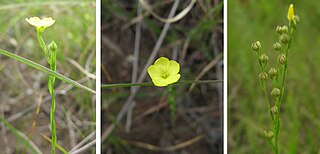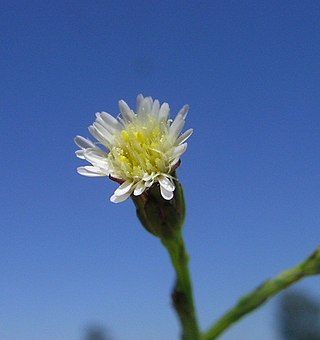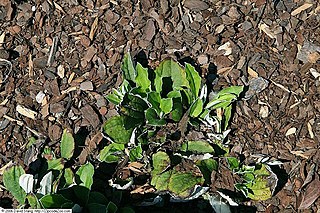
Linum (flax) is a genus of approximately 200 species in the flowering plant family Linaceae. They are native to temperate and subtropical regions of the world. The genus includes the common flax, the bast fibre of which is used to produce linen and the seeds to produce linseed oil.

Linaceae is a family of flowering plants. The family is cosmopolitan, and includes about 250 species in 14 genera, classified into two subfamilies: the Linoideae and Hugonioideae. Leaves of the Linaceae are always simple; arrangement varies from alternate to opposite or whorled. The hermaphroditic, actinomorphic flowers are pentameric or, very rarely, tetrameric.

Drosera capillaris, also known as the pink sundew, is a species of carnivorous plant belonging to the family Droseraceae. It is native to the southern United States, the Greater Antilles, western and southern Mexico, Central America, and northern South America.

Gaillardia pulchella is a North American species of short-lived perennial or annual flowering plants in the sunflower family.

Coreopsis tinctoria, commonly known as plains coreopsis, garden tickseed, golden tickseed, or calliopsis, is an annual forb. The species is common in Canada, northeast Mexico, and most of the United States, especially the Great Plains and Southern States. It is introduced into many countries in Europe and Asia.

Linum lewisii is a perennial plant in the family Linaceae, native to western North America.

Linum perenne, the perennial flax, blue flax or lint, is a flowering plant in the family Linaceae, native to Europe, primarily in the Alps and locally in England. It has been introduced into North America, where it can be found on mountain ridges, wooded areas, and in sandy plain habitats of the sagebrush steppe, growing near sagebrush and rabbitbrush (Chrysothamnus).

Tradescantia virginiana, the Virginia spiderwort, is a species of flowering plant in the family Commelinaceae. It is the type species of the genus Tradescantia, native to the eastern United States. Common names include Virginia spiderwort, common spiderwort, lady’s tears, and spider lily.

Erigeron annuus, the annual fleabane, daisy fleabane, or eastern daisy fleabane, is a species of herbaceous flowering plant, annual or biennial, in the family Asteraceae.

Croton alabamensis, known as Alabama croton, is a rare species of flowering plant in the spurge family, Euphorbiaceae, that is endemic to Texas and Alabama in the Southeastern United States. It has two varieties whose ranges are separated by more than 1000 km: Croton alabamensis var. alabamensis is found in two central Alabama counties, while Croton alabamensis var. texensis is found in three counties in Texas.

Linum grandiflorum is a species of flax known by several common names, including flowering flax, red flax, scarlet flax, and crimson flax. It is native to Algeria and Tunisia, but it is known elsewhere in Northern Africa, Southern Europe and in several locations in North America as an introduced species. It is an annual herb producing an erect, branching stem lined with waxy, lance-shaped leaves 1 to 2 centimeters long. The inflorescence bears flowers on pedicels several centimeters long. The flower has 5 red petals each up to 3 centimeters long and stamens tipped with anthers bearing light blue pollen. It can on occasion be found as a casual well outside its normal established range; records from the British Isles, for example, are reasonably frequent but, grown as an annual, it rarely persists for more than one season.

Linum puberulum is a species of flax known by the common name plains flax. It is native to the western and midwestern United States from California to Nebraska to Texas, where it grows in dry, open habitat including desert, semi-desert, hills and low mountains. It is a downy-haired perennial herb producing an erect, branching stem lined with glandular linear leaves up to about 1 centimeter long. The inflorescence is a wide open cyme of golden yellow to yellow-orange flowers each with five petals 1 to 1.5 centimeters in length. The fruit is a capsule about 4 millimeters wide.

Linum medium, common name stiff yellow flax, is a species of Linum (flax) native to eastern North America. It is found as far west as Texas and Wisconsin, east to the Atlantic Ocean, north to Ontario and Maine, and south to southern Florida. It is also found in The Bahamas.

Aletris farinosa, called the unicorn root, true unicorn, crow-corn, white colic-root or white stargrass, is a plant species found across much of the eastern United States. It has also been reported from the southern part of Ontario, Canada. It is known from every state east of the Mississippi River except Vermont, as well as Texas, Oklahoma, Arkansas and Louisiana. Its native habitats include moist peaty, sandy or gravelly areas.

Symphyotrichum subulatum, commonly known as eastern annual saltmarsh aster or, in Britain and Ireland where it is naturalized, annual saltmarsh aster, is an annual plant in the family Asteraceae native to the eastern United States and the Gulf Coast to Texas. The species grows primarily in coastal salt marshes, although in the Ozarks it occurs as a non-marine weedy variety.

Antennaria parlinii, known as Parlin's pussytoes, is a herbaceous flowering plant in the family Asteraceae. Like other species in the genus, the plant is dioecious. It is widespread across eastern and central Canada and eastern and central United States, from Manitoba to Nova Scotia south as far as Texas and Georgia.

Linum strictum, commonly known as rigid flax, upright flax, and upright yellow flax, is a species of flax with a rigid stem, from whence it derives its taxonomic name, growing to a height of 10–45 cm. The plant is endemic to the Mediterranean region, as well as native to Sudan, Ethiopia, Eritrea, Croatia, Bosnia and Herzegovina, Montenegro, Crimea, Albania, Portugal, Jordan, Iraq, Iran, Madeira, the Canary Islands, the Transcaucasus, Saudi Arabia (Asir), Bahrain, Qatar, Pakistan, and northwest India. It features highly in classical Hebrew and Greek literature, owing principally to its cultivation for its plant fiber, linen, but also for its edible seeds and culinary foliage.

Radiola linoides is the sole species in the Radiola genus, a monotypic genus of flowering plants belonging to the family Linaceae. It has the common names of 'allseed' and 'flaxseed'. It has a very short stem which is repeatedly subdivided, with a pair of very small leaves and a single white flower at each fork and at the end of the branches. It has leaves which are opposite arranged, oval and sessile.


















